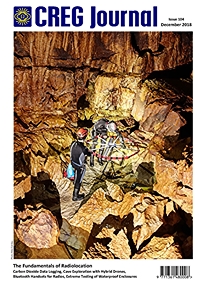
- The most recent issue to be published was 125
- For further information, please see Publishing/Despatch Schedule
- Database last updated on Wed, 03 Apr 2024 16:35:02 +0100
- Online access is currently available for all issues. Some of
the older issues are bit-map scans rather than digital copies.
journal scans.
- Online voting for CREG articles was withdrawn in June 2022. For info see
Voting for CREG articles
Contents of journal 104
December 2018
This page may take a few
seconds to load. Please wait ...
- CREG Journal 104 (0-24)
(PDF 4.6MB)
  Individual articles may be available below Individual articles may be available below
- This issue has a cover date of December 2018 and was published on 3 December 2018.
-
- Front Cover (1)
(PDF 1.1MB)

- Radiolocation in the resurgence of Cabouy, France with a 1.3m loop and Brian Pease-designed Class-E 3496Hz beacon. Photo: Niko Gerdau.
-
- Contents (2)
(PDF 567KB)

- List of contents and masthead information. CREG Spring 2019 Field Meeting.
-
- Simple Enclosure is Waterproof to 400 Metres (3-6)
(PDF 529KB)

- David Gibson describes a low-cost equipment housing for underwater use at depths of, potentially, up to 1000m although caving applications would normally be at a shallower depth of under 100m. Possible uses of this housing would be as part of a data-logger designed to monitor water depth (via a pressure sensor), as well as temperature, electrical conductivity and possibly turbidity and fluorescence.
-
- Introduction to Cave Radiolocation (7-8)
(PDF 508KB)

- Radiolocation, an application of LF, VLF or ULF through-the-earth radio, allows an underground station to be located from the surface. This is a valuable technique in cave surveying as Mike Bedford explains. This article is #2 in our Fundamentals series.
-
- Cave Exploration with the Inkonova Hybrid Drone Family (9-11)
(PDF 561KB)

- Pau Mallol, Founder and CTO of Inkonova AB, introduces the company's range of innovative hybrid drones which have freely-rotating retractable wheels. He describes how one model has been trialled in a lava tube in Tenerife.
-
- Wet & Dry (12)
(PDF 269KB)

- Ruggedisation, waterproofing & construction techniques. Electrical Safety by Tony Haigh.
-
- The Hidden Earth Timetable Display – Part 3 (13-15)
(PDF 282KB)

- David Gibson continues with his series of articles on using Raspberry Pi computer modules as the basis for a network of computers that can provide information displays. This article includes an example of how to run a web browser in 'kiosk mode' on the Raspberry Pi, and how the Raspberry Pi can report its id to the system's web server.
-
- Letters and Announcements (16)
(PDF 273KB)

- Caving Conferences, Peter Cousins, Optical Flash Slave Update David Gibson.
-
- Web Watch (16) For download see previous item
- Peter Ludwig delves into the Internet once more and comes up with some fascinating finds. Batteries, robots, 3D printing and more...
-
- We Hear (17)
(PDF 269KB)

- Roundup of news and events – Mike Bedford brings us the latest to impact the world of cave radio and electronics. Panasonic Introduces De-stinking Technology, Sweat-powered Radio, Atomic Radio Receivers, Chemical Lighting.
-
- Carbon Dioxide Data Logging in Caves – Part 1 (18-19)
(PDF 509KB)

- In this first of two articles, Bob Mehew considers a requirement to monitor CO2 levels in caves. He reviews available sensors, describes the development of a prototype logger using an SCD30 non-dispersive infrared sensor, and shows preliminary results.
-
- Radiolocation at Pen Park Hole (20)
(PDF 261KB)

- Mike Bedford reviews a paper describing the use of radiolocation to help preserve a cave of significant scientific and historical interest.
-
- Bluetooth on a Budget (21-22)
(PDF 641KB)

- Bluetooth handsets and headsets for radios are restricted to specific models, limited in availability, and tend to be very expensive. Adapting low-cost off-the-shelf Bluetooth devices for incorporation into self-build projects can be a viable option. Tony Haigh describes his experience with two such devices.
-
- CREG Field Meeting: October 2018 (23)
(PDF 250KB)

- Activities at our most recent field meeting were mostly related to communications. Robin Gape outlines the weekend's activities.
-
- The Adventures of GREG (24)
(PDF 893KB)

- Illustration by Adrian Higgins, words by Mike Bedford.
-

|

View Contents:

BCRA is a UK registered charity and is a constituent body of
the British Caving Association,
undertaking charitable activities on behalf of the BCA.
BCRA publishes a range of periodicals and books.
Click here for further information.
|
Searching
To Search our pages using Google, type a search
string in the box at the top of the page and hit your Return key
You can also search our publications catalogue at the British Caving Library
The CREG Journal Search Engine is a new, powerful search engine which will, sometime, be extended
to cover Cave & Karst Science. We have a keyword search facility on our Cave Science Indexes pages but this may be rather out-of-date.
|
For staff use: Link to Database
Show/Hide
download figures next to each item (if available and non-zero; you might need to refresh page first). Counters last
reset on Thu 03-Jan-2019 17:29:28 +00:00. The figures are non-unique
click-throughs.
|








